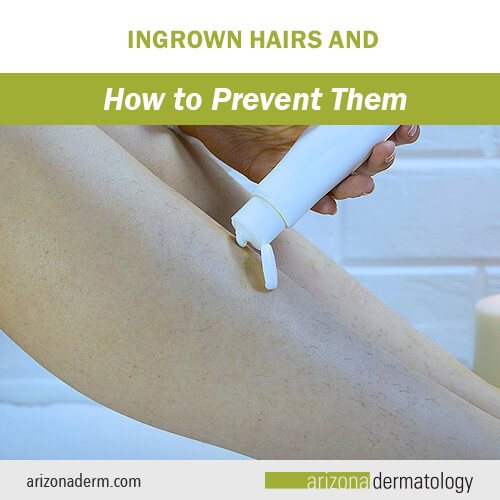 Ingrown hairs are hairs that do not grow properly out of the follicle. Instead, they turn back and grow into the skin. Some ingrown hairs pierce the lining of the hair canal and grow trapped under the skin. This can especially be a problem when the ingrown hair creates a bump, papule (red inflamed bump) or pustule (pus-filled bump), or when many ingrown hairs occur in the same area. This often happens to men in their beard area. Ingrown hairs may be tender or itchy. If you struggle with ingrown hairs, we offer some insight into what causes them and how to prevent and treat them.
Ingrown hairs are hairs that do not grow properly out of the follicle. Instead, they turn back and grow into the skin. Some ingrown hairs pierce the lining of the hair canal and grow trapped under the skin. This can especially be a problem when the ingrown hair creates a bump, papule (red inflamed bump) or pustule (pus-filled bump), or when many ingrown hairs occur in the same area. This often happens to men in their beard area. Ingrown hairs may be tender or itchy. If you struggle with ingrown hairs, we offer some insight into what causes them and how to prevent and treat them.
What causes ingrown hairs?
Shaving. Shaving the hair creates a sharp edge at the end of the hair shaft. Most of the time this isn’t a problem. But shaving can tug on the hair shaft, causing the hair to stretch and then retract into the hair follicle, where it can become ingrown. Sometimes a recoil effect from the act of shaving can cause the hair to curl backwards and become ingrown.
Hair removal. Tweezing and waxing pulls the hair from the follicle. The new hair growing to replace it may fail to properly exit the follicle, and become ingrown. If a hair removal attempt fails, the hair can stretch and coil back, creating a corkscrew effect that facilitates ingrown hair growth.
Friction. Hairs that experience rubbing over time (from elastic in the groin area, for example) can become coiled and deformed and create ingrown hairs.
Normal hair growth. Sometimes ingrown hairs happen without a particular cause. Naturally curly hair has a tendency to ingrow more than naturally straight hair. Many men with curly facial hair are prone to pseudofolliculitis barbae, also called “razor bumps”. These are ingrown hairs that occur from shaving the beard area.
Why you should treat or prevent ingrown hairs
Ingrown hair can not only create uncomfortable and unsightly bumps, but it can cause scarring and discoloration over the long term. This often occurs on the face and neck in men and in the armpits and bikini area in women, due to shaving.
Hyperpigmentation. Inflammation of the skin can leave a temporary or even permanent brown mark on the skin after it heals. Dark skin or skin that is exposed to the sun may remain hyperpigmented for a longer period of time.
Infection and Scarring. If ingrown hairs become infected with Staph bacteria, they have a higher likelihood of causing permanent scarring. Any ingrown hair that becomes very red, tender and swollen should be seen by a dermatologist.
Preventing Ingrown Hairs
If you are prone to ingrown hairs, you can do the following to help prevent them.
- Physical Exfoliation. Use an exfoliating shower cloth or facial sponge with your skin cleanser. Massage in a gentle, circular movement that will loosen curly hair. Pat your skin dry and apply a moisturizer.
- Benzoyl Peroxide or Salicylic Acid. These active ingredients, usually used to treat acne, loosen and remove dead skin cells that can clog follicle openings and contribute to ingrown hairs.
- Retinol. Retinol will also exfoliate skin, and it also helps to reduce hyperpigmentation and scarring. A dermatologist can prescribe a medical-grade retinol product that you can use at night.
Tips for Shaving
Also, follow these shaving tips to reduce your chances of getting ingrown hairs.
- Wash and rinse your skin well with a gentle cleanser before shaving to remove bacteria.
- Never dry shave. Always use a lubricating gel or shave lather.
- Use a clean, sharp razor. Rinse the razor between each pass.
- Avoid multi-blade razors. These increase the chances of ingrown hairs because the first blade stretches the hair while the second cuts it.
- Always shave in the same direction of hair growth.
- Don’t pull or stretch your skin when you shave.
- Avoid close shaves, especially if you have naturally curly hair. If you use an electric razor, set it to leave a slight stubble.
- Rinse your skin with cool water after shaving to reduce inflammation.
- Apply moisturizer after shaving.
If you do get an ingrown hair, take the following steps:
- Stop shaving, tweezing, or waxing the area until it heals.
- Watch for infection. Treat the area with hydrogen peroxide and a topical antibiotic. If the ingrown hair becomes red, swollen, and tender, see your dermatologist.
- Avoid picking, scratching at, or popping pustules created by ingrown hairs.
- Avoid sun exposure or use a mineral sunscreen with an SPF of 50 to prevent post-inflammatory hyperpigmentation.
Treatment for Hyperpigmentation and Scarring
If you already have dark spots or scarring from ingrown hairs, we can help.
Chemical peels. We offer a variety of chemical peels, from light to deep, that can remove the outer layers of skin cells and help restore smooth, healthy skin.
Intense pulsed light treatment. IPL targets darkened areas of skin to break down melanin and reduce the look of dark spots.
Microdermabrasion. This safe, non-invasive procedure removes outer layers of skin to promote healthy new skin growth.
A consultation with a member of our MedSpa team will help you to decide which treatment is best for you and your skin.


